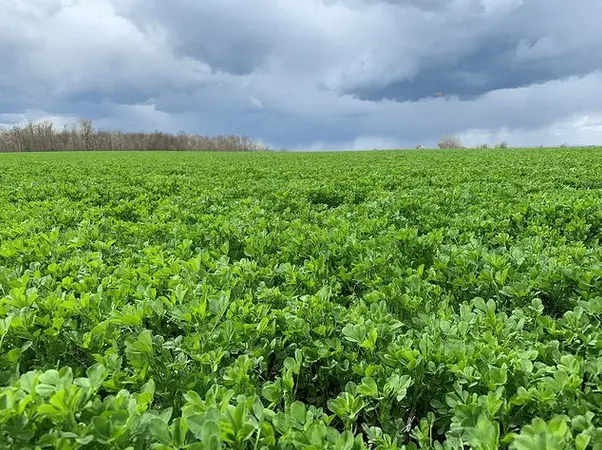Plant Phenotyping For Drought Resistance Of Alfalfa


Scientific interest in the drought resistance of alfalfa has always been significant. This is primarily because alfalfa ranks among the most drought-tolerant crops. However, with the ongoing decline in available water supply for irrigation and the increase in climate change-related droughts, there is an urgent need to develop alfalfa cultivars that exhibit enhanced drought resilience.
Alfalfa as one of the main forage crops
Alfalfa, also known as lucerne or Medicago sativa, is the oldest crop grown exclusively for forage. Scientists have researched this plant as feed for livestock for hundreds of years. The cultivation of alfalfa, as a vital forage crop, is backed by scientific proof of its high nutritional value. Indeed, commercial companies and farms utilize lucerne for grazing, hay, silage, as well as a green manure and cover crop. The estimated global cropping area for alfalfa exceeds 30 million hectares (Singer et al., 2021).
Most temperate regions worldwide are suitable for alfalfa cultivation. In regions with mild winters, there are environmental and geographical prerequisites for growing alfalfa continuously for 3–4 years. In contrast, in areas with cold winters, the growth duration extends to 6–9 years, with a dormant phase during the winter.
Alfalfa can be genetically hybridized to develop other members of the genus, primarily perennial species. The perennial alfalfa achieves its maximum yield in the second year of cultivation.
Alfalfa thrives in well-drained soils rich in phosphate, lime, and potash. With its deep taproot system, it can withstand severe droughts. Traits such as forage quality and yield, resistance to lodging, and early spring vigor are vital for alfalfa improvement.
Furthermore, the nitrogen acquisition qualities of alfalfa deserve mention. Nitrogen fixation is a critical pathway for achieving greater yields and higher N use efficiency in legume and cereal intercropping systems (Shao et al., 2021). Alfalfa can fix up to 350 kg N ha-1 (Carlsson and Huss-Danell, 2003).
Overview of the Requirements for Plant Growth and Development of Groundnut
One of the widespread agriculture practises is to grow alfalfa as a cover crop. Otherwise, it can be a part of a crop rotation. In this case, alfalfa can significantly improve the soil nutrient levels. Simultaneously it lessens the need for synthetic fertilizers. For example, in Spain there are successful cases of growing alfalfa in crop rotating system, when rotations that include forage legumes reduce the use of fertilizers and therefore limit greenhouse-gas emissions (FAO, 2019).
Alfalfa as forage crop
Alfalfa often called the queen of the forages and it tops all other perennial forage crops as a producer of home-grown feed. Previous agronomical, physiological, and biochemical studies strongly suggest that alfalfa is more drought tolerant than pea and ureide-producing grain legumes (Wenli et al, 2016)

Drought resistance of alfalfa as important aspect of the future supply
Drought is one of major environmental determinants of plant growth and productivity. Alfalfa is relatively drought tolerant in comparison to many other crop species. This feature is a suggested result of the typical presence of a deep tap root. At the same time, its production depends upon irrigation in many growing regions.
Moreover, it consumes a particularly high amount of water due to its long growing season and dense canopy.There are a few alfalfa growing strategies to choose when faced with a drought (University of California, 2015). For example, the most productive ways are to:
- reduce crop acreage (“triage,” or elimination of irrigation on some fields)
- partial irrigations over the entire season (so-called “starvation diet”)
- full irrigations for portions of the season followed by complete dry-down (“cold turkey” mid-season cut-off)
At the same time scientists work on development of drought tolerant alfalfa varieties. Recently a group of crop researchers from Canada has contributed a new paper. These scientists represent Agriculture and Agri-Food Canada (particularly, Lethbridge Research and Development Centre and London Research and Development Centre) in collaboration with the Department of Agricultural, Food and Nutritional Science at the University of Alberta.
The focus of their research was on identification of differential drought response mechanisms in Medicago sativa subsp. sativa and falcata through comparative assessments at the physiological, biochemical, and transcriptional levels. This publication is a part of the MDPI: Plants, published on October 5, 2021.
Overview of the research about drought resistance on alfalfa
There is evidence that the genetic diversity of Medicago sativa has been reduced during the domestication process – as a result cultivated alfalfa has lost about 30% of its genetic diversity compared to wild populations (Muller et al, 2006). Also, there are suggestions that landraces and wild relatives of alfalfa encompass greater genotypic and phenotypic diversity than commercial cultivars. They have better developed adaptive traits to survive in extreme drought stress conditions. Hence, it is a widespread practice to breed new lines of alfalfa as crosses between gene pools of cultivated alfalfa (M. sativa subsp. sativa) and wild relatives belonging to the primary (M. sativa subsp. falcata) and tertiary (M. arborea) (Inostroza, 2021).
Canadian researchers have chosen M. sativa subsp. falcata as a close relative of the predominantly cultivated M. sativa subsp. sativa. Its certain accessions has demonstrated superior performance under drought.
That is why, the crop scientists carried comparative physiological, biochemical, and transcriptomic evaluations of an as of yet unstudied drought-tolerant M. sativa subsp. falcata accession (PI 641381). Also they researched a relatively drought-susceptible M. sativa subsp. sativa cultivar (Beaver) to increase overall understanding of the molecular mechanisms behind the enhanced ability of falcata to withstand water deficiency.
Materials and Methods of this Research
Scientists exploited some of the following materials and methods in the course of the research: Seeds of tetraploid M. sativa subsp. falcata accession PI 641381 were obtained from the United States Department of Agriculture — Agricultural Research Service Germplasm Resources Information Network; Leaf area was resolved using the Petiole plant leaf area meter app. Dry weight was then determined after drying at 80 °C for 24 h. Specific leaf area was established by dividing leaf area by dry weight in each case. Raw reads were trimmed using the ‘sickle’ script in Linux with default parameters, and read quality was assessed using the FASTQC tool; High-quality filtered reads were mapped to the Medicago truncatula genome using Tophat2. Venn diagrams were generated using freely available software SEA of either up-regulated or down-regulated DEGs observed between control and drought conditions for both ‘sativa’ and ‘falcata’ were carried out using AgriGO v2.0 Heat maps were generated using the freely available Morpheus tool Visualization of DEG-associated pathways between ‘sativa’ and ‘falcata’ under both well-watered and control conditions was performed using MapMan V3.6 software
Findings of the drought resistance of alfalfa
The results of the scientific work are promising and provide more opportunities for further research of drought tolerance of alfalfa. Unlike the small number of falcata genotypes assessed previously, falcata PI 641381 may exploit smaller, thicker leaves. It also demonstrates an increase in the baseline transcriptional levels of genes encoding particular transcription factors, protective proteins, and enzymes involved in the biosynthesis of stress-related compounds.
These findings provide proof of how different falcata accessions/genotypes may employ distinct drought response mechanisms. Finally, the study provides a suite of candidate genes to facilitate the breeding of varieties with strong drought resistance of alfalfa in the foreseeable future.

